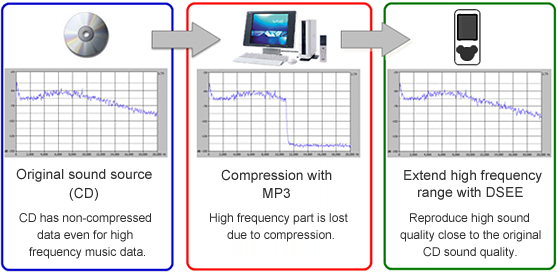DSEE (Digital Sound Enhancement Engine) by Sony
Listen to the music like it was meant to be. Degraded sounds of compressed audio are now improved and the high-frequency range restored, reproducing natural, high-quality sounds as close to the original source as can be. DSSE Sony is meant to restore sounds back to original.
Digital Sound Enhancement Engine (DSEE) is Sony’s originally developed audio bandwidth enhancement technology. DSEE is a technology to enhance the sound quality of compressed audio files by restoring high-range sound removed by the compression process.When original music source is compressed with MP3 (or AAC/WMA), high-frequency part of music source will be lost. The technology of DSEE enables to restore high-frequency part and reproduces high-quality sound which is close to the original CD sound source. By activating the [DSEE(Sound Enhance)]feature, you can hear a rich and natural sound almost exactly like the original source.
 |
| DSEE Technology |
DNSe (Digital Natural Sound engine) by Samsung
DNSe or the Digital Natural Sound engine is a DSP audio enhancement technology developed by Samsung in 2003 and further on implemented throughout many of their product lineups - from TVs and DVD players to portable music players and lately - mobile phones.
As Samsung puts it, the aim of DNSe is to restore the best sonic experience to the end user. Purportedly, the sound engine yields higher quality sound with more natural effects than conventional methods by reproducing the 'genuine' stereo sound intended by the music content creators. It achieves this by actively working on overcoming the limitations of earphones and less-than-ideal speakers to offer realistic stereo and deep bass sounds.
In addition, Samsung has created ideal listening presets that further compensate for the native restrictions of portable multimedia players. The system uses several basic processing methods aiming at various imperfections of the sound produced by portable players.
Concert Hall recreates life-like reflected and reverberated sounds to simulate the experience of a live performance in a concert hall. 3D speaker separates and combines sound to create a realistic sense of both space and distance through small-sized speakers. Clarity enhancement tries to electronically restore the distorted harmonics of the digitally compressed music. Bass Extension applies an electronic harmony logic to correctly play hi-fidelity sounds at an ultra-low frequency through earphones or small-sized speakers. And finally, Street mode selectively adjusts the volume so that the tiny notes are audible even in the loud street environment without the uncomfortable boosting of the general volume level.
The DNSe sound enhancement system combines those sound enhancements with different equalizer settings to create various user-centric presets to suit the most common listening scenarios. If that is not enough, the system allows creating custom presets as well.
Samsung DNSe is not to be confused with the Samsung proprietary DNIe (Digital Natural Image engine) technology. DNIe is used in Samsung plasma and high definition television sets (HDTV). Purportedly, DNIe offers better detail than conventional televisions by using four proprietary processes that optimize and enhance image quality: a Motion Optimizer, a Contrast Enhancer, a Detail Enhancer, and a Color Optimizer.
So, which one is the best...? just hear the difference.
As Samsung puts it, the aim of DNSe is to restore the best sonic experience to the end user. Purportedly, the sound engine yields higher quality sound with more natural effects than conventional methods by reproducing the 'genuine' stereo sound intended by the music content creators. It achieves this by actively working on overcoming the limitations of earphones and less-than-ideal speakers to offer realistic stereo and deep bass sounds.
In addition, Samsung has created ideal listening presets that further compensate for the native restrictions of portable multimedia players. The system uses several basic processing methods aiming at various imperfections of the sound produced by portable players.
Concert Hall recreates life-like reflected and reverberated sounds to simulate the experience of a live performance in a concert hall. 3D speaker separates and combines sound to create a realistic sense of both space and distance through small-sized speakers. Clarity enhancement tries to electronically restore the distorted harmonics of the digitally compressed music. Bass Extension applies an electronic harmony logic to correctly play hi-fidelity sounds at an ultra-low frequency through earphones or small-sized speakers. And finally, Street mode selectively adjusts the volume so that the tiny notes are audible even in the loud street environment without the uncomfortable boosting of the general volume level.
The DNSe sound enhancement system combines those sound enhancements with different equalizer settings to create various user-centric presets to suit the most common listening scenarios. If that is not enough, the system allows creating custom presets as well.
Samsung DNSe is not to be confused with the Samsung proprietary DNIe (Digital Natural Image engine) technology. DNIe is used in Samsung plasma and high definition television sets (HDTV). Purportedly, DNIe offers better detail than conventional televisions by using four proprietary processes that optimize and enhance image quality: a Motion Optimizer, a Contrast Enhancer, a Detail Enhancer, and a Color Optimizer.
So, which one is the best...? just hear the difference.
